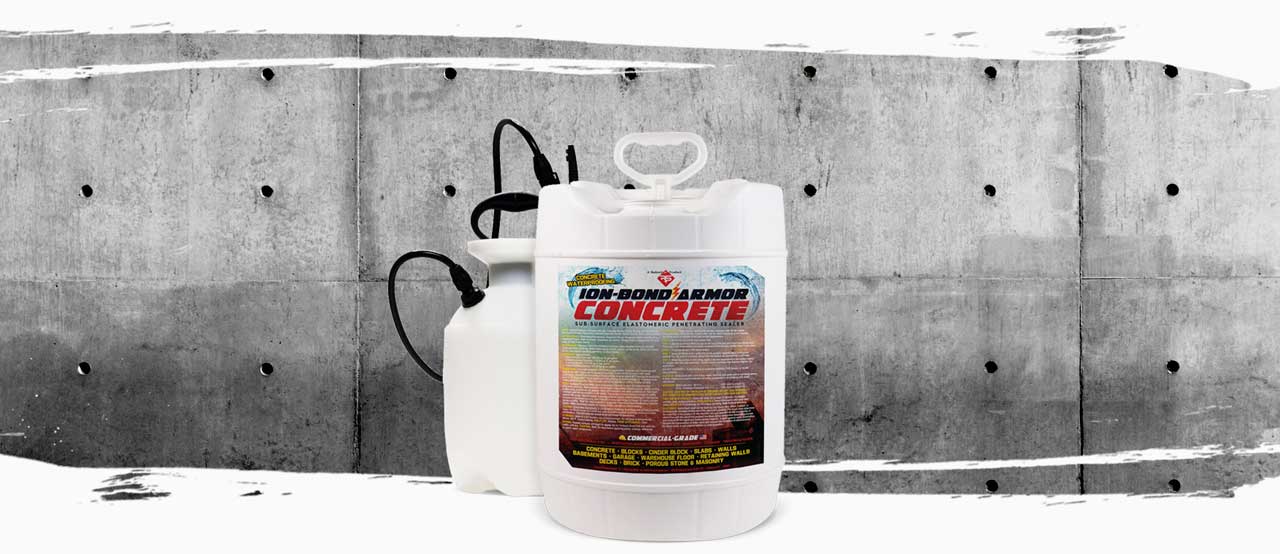Product Information
IonBond Armor is a state-of–the-art, commercial-grade, water based, polysiloxane sealer formulated to penetrate deep into concrete, concrete blocks, cinder blocks, CMU, masonry, and porous building materials. Forms an elastomeric waterproof barrier well below the surface. Suitable for indoor or outdoor use, horizontal and vertical surfaces, commercial and residential, and above or below grade applications.
Uses
Indoor/Outdoors. Poured concrete, Concrete Blocks, Cinder Blocks, Splitface Blocks, Pre-Cast Concrete, Fibercrete, Colored Concrete, Gunite, Mortar, Stucco, Brick, Porous Stone.
Applications
Stamped Concrete, Polished Concrete Slabs, Modified Hydraulic Cement, Concrete Floor Coatings. Water leaks due to cracks, seams, corner joints, holes, and similar which may require caulking, patching, or other repairs.
Limitations
Dense stone and tiles, rock, countertops, showers, hydraulic cement, epoxy or chemically-modified grout.
Coverage
- Indoor Poured Concrete: 200-225 sq. ft. per gallon.
- Outdoor Poured Concrete: 175-200 sq. ft. per gallon.
- Concrete Blocks: 125-150 sq. ft. per gallon.
- Cinder Blocks: 75-125 sq. ft. per gallon.
Surface Conditions
Concrete should be DRY prior to application. Concrete may require several days to dry after heavy rain or pressure washing. Avoid rain for 24 hours after sealer application. Ambient air and surface temperatures must be above 40o F during the application and for 72 hours after. Avoid applying to hot surfaces in direct sunlight, or in strong winds and excessive humidity. New concrete should be allowed to cure for at least 28 days.
Testing
Recommended! Concrete varies greatly in composition, finishing techniques, and surface porosity. Apply Ion-Bond Armor to a test area to confirm surface suitability and ensure sealer penetration. Treated surfaces should show no change in appearance.
Surface Prep
Surfaces must be clean, bare and porous. Remove paints, sealers, curing compounds, adhesives, oil, grease, mold, efflorescence and other contaminants that might interfere with the penetration of the sealer. Hard-troweled concrete surfaces require chemical etching or mechanical abrasion to increase porosity. A sufficiently porous surface should readily absorb the sealer. Use PowerEtch Concrete Etcher & Cleaner to obtain a proper surface profile. If chemical cleaners or concrete etchers are used, be sure to thoroughly rinse and remove them prior to sealer application. Mask surfaces not intended to be sealed. Vacuum or blow off excessive dust and loose particles. Make necessary repairs to cracks, joints, and defects before sealing.
Shelf Life
45-DAYS | 14-DAYS ONCE THE ACTIVATOR BOTTLE IS ADDED.
Application
Hand-pump sprayer equipped with fan tip nozzle (preferred), airless sprayer regulated below 40-psi, roller, or brush.
STEP 1: Attach mixing tool to your power drill.
STEP 2: Remove cap on the top of the pail and insert the mixing tool. Thoroughly mix while adding the entire contents of the activator bottle (about 3 minutes).
STEP 3: Fill pump-sprayer with mixed sealer.
STEP 4: Spray Ion-Bond Armor uniformly to the surface, maintaining a continuous wetting film. On vertical surfaces, apply from the bottom up maintaining a wet edge.
STEP 5: Spray Ion-Bond Armor uniformly to the surface, maintaining a continuous wetting film. On vertical surfaces, apply from the bottom up maintaining a wet edge.
Applying Ion-Bond After RadonSeal
If applying after the application of RadonSeal Penetrating Concrete Sealer, wait 10+ days to apply Ion-Bond Armor to the surface.
Clean Up
Rinse tools with water. Remove overspray with a wet towel before it dries. Dispose of unused material and empty containers in accordance with local regulations.
Drying
Treated surfaces will begin to appear dry in 1-4 hours. Avoid foot and vehicular traffic until dry. Wait 10+ days before applying paints, coatings, adhesives, or patch repair compounds.
